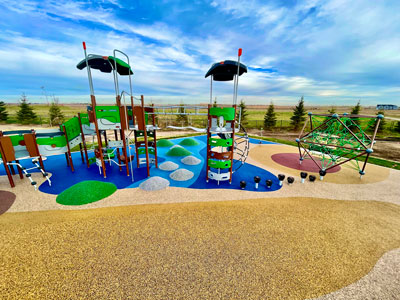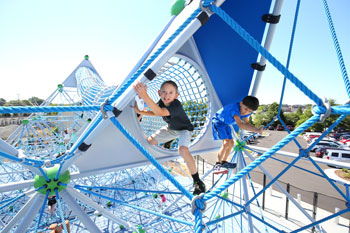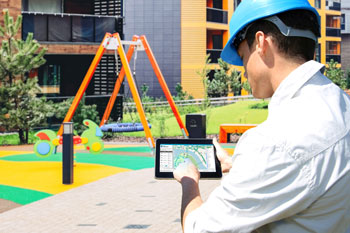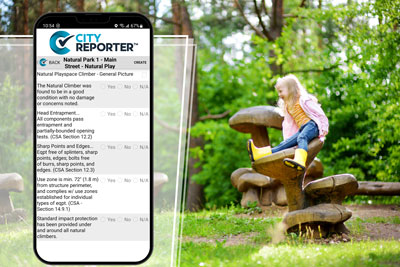Playground safety has evolved so much that the bare minimum is simply assumed, and risk is being carefully added.
“Safe doesn’t mean boring!” said Brad Pittam, president of the International Play Equipment Manufacturers Association (IPEMA). “With the vast enhancements in technology, we’ll likely see more interactive playground equipment that lets children participate in cognitive enhancement and group interaction games in a more immersive setting. What’s exciting about this is playground equipment manufacturers’ drive to make playgrounds creative and challenging while meeting all of the safety requirements.”
The progress toward maximum safety involves better design, like beginner challenges next to more difficult ones, enhanced sightlines for parents, improved materials to reduce rust and splinters and cushion falls, advanced technology for impact testing, brighter and less expensive lighting, mobile apps that ease maintenance and inspection, and a new philosophy that incorporates and encourages risk so kids don’t try activities on equipment not designed for it.
“Playgrounds today are more varied and allow children to take more risks, push their limits and explore the wonders of these unique playground spaces,” said Pittam. “Through advancements in innovation, new technology, updated materials and research, playgrounds are becoming not only more advanced but safer for children in the process.
“It’s no secret that children have a natural inclination to take risks. These risks—especially with heights—and new playground features like towers or elevated surfaces, compel kids to take risks … in a safer, injury-mitigating setting.”
Playgrounds should provide visitors with a sense of perceived risk, said Alan Kavanaugh, director of loss control and risk management for an IT services company that provides mobile-app playground inspection services, without ever actually putting them in the way of real danger.

“Designing spaces to protect kids from falls and injuries is essential,” said Kavanaugh. “When it comes to playgrounds, a certain level of risk is essential for promoting development, both physically and mentally. Hazards are the elements we aim to minimize or eliminate. For instance, when children play on playground equipment, there is a risk of injury, but our goal is to prevent any severe injuries, such as neck and head injuries, from happening.”
Scott Roschi, creative director for a playground equipment manufacturer in Delano, Minn., added “One of the ideas that has helped playground equipment become inherently safer has to do with the design of more challenging and less prescribed play. It seems that this would be opposite thinking. However, creating spaces that truly challenge children on the playground keeps them engaged in trying to master those challenges. That focus means they are not bored and not trying things that the playground is not designed for, which often leads to injuries.”
Maintenance & Inspection
While design, equipment and surfacing innovations ensure new and updated playgrounds begin as safe spaces, that status can only be maintained through regular maintenance and inspection, Kavanaugh said. His company’s software has empowered playground operators to conduct thorough safety assessments and efficiently address potential hazards. This technology allows for more proactive and precise maintenance, leading to safer playgrounds for children and their families. Additionally, the software facilitates compliance with safety standards and regulations, ensuring that playgrounds remain secure and accessible for all. “Ultimately, innovations like this contribute to a higher level of safety and peace of mind in the design and maintenance of modern playgrounds,” said Kavanaugh.
Kavanaugh added that the software can also help plan a playground’s budget, as a frequently overlooked aspect during budget discussions is the cost of inspection and maintenance, which should be an integral part of the budgeting process. “Using a manual paper-based inspection and maintenance system can result in significant human resource and administrative costs,” he said. “In contrast, adopting a digital-based process can mitigate these inefficiencies and cut time-related expenses by more than 50%.”
Doug Taylor, owner of Canada-based Taylor Risk Solutions, said communities should look for safety and risk consultants that do more than identify hazards. The goal with all the inspections his company performs is to provide a value-add to the client. “We always approach each job as a partner/consultant versus an inspector,” Taylor said. “This way we work with our clients on how to address the concerns we note during our audits, providing possible solutions and mitigation steps. We are also available to all our clients long after the audits have been completed to assist with any of the playground questions or plans.
“This includes a wide variety of services such as developing manuals which can be passed onto parent or community groups looking to purchase or install a playground, to being a part of the planning committees, etc. We also provide workshops to staff on why they are doing playground inspections and the formats they should follow.”
Taylor said the most common mistake he sees is a lack of planning that comes from not understanding the importance of maintaining playgrounds and the complexity and magnitude of detail required when looking to install a new playground, including equipment upgrades. “Some clients have really grasped the importance of having their audits completed on a regular basis and the continual update and maintenance of equipment,” Taylor said. “For others, it’s still a foreign concept.”

The overall safety of playgrounds has increased, he said, simply because more stakeholders have embraced it.
“We’ve really seen a buy-in by many playground owners, installers and operators to ensure their playground areas are as safe as can be,” Taylor said. “The equipment is obviously being manufactured to safer standards and the variety of play equipment out there is extensive, including inclusive playgrounds, nature play areas, etc.”
While prioritizing safety has grown for all involved, using technology, creativity and innovation to make play spaces less hazardous, Taylor said that as a safety inspector he’s always alert. “I feel with the design boundaries of playground equipment being constantly pushed by the manufacturers that we need to stay apprised of the potential risks in these new designs,” he said. “While it might meet the current standards, should children be hurt playing on the equipment, then we need to refine what we look for. There is new equipment out there that I am sure we’ll start to see injuries occur on and thus, we need to be continually aware of and adapt accordingly.”
Basics & Beyond
Roschi said regardless of changes to the tools and tactics of playground safety, there are foundations:
- Safety Standards: Upholding safety standards like those of ASTM and the U.S. Consumer Products Safety Commission (CPSC) isn’t just a requirement, said Roschi, it should be a promise to parents that their children will play in a safe and secure play environment.
- Age-Appropriate Design: Designing age-appropriate equipment isn’t a task; it’s a way of ensuring every child’s developmental needs are met during play, Roschi said. “We place a challenging event next to an easier event to allow the kids to engage with the play event that they are comfortable with and work up to the more challenging one,” he said. “This is a great example of how we create parallel play opportunities.”
- Proper Surfacing: The choice of surfacing isn’t just a technical decision; it’s about creating a cushion of safety that allows children to explore and take risks without fear, Roschi said. “Surfacing also has so much to do with creating a space for inclusion.” he said. “Using unitary surfaces (not wood chips or shredded tire, for example) allows for those using mobility devices and even new walkers to navigate and get to more of the play space, giving the most and easiest access to the playground.”
The need for ever-safer equipment and surfaces keeps pace with a generation and future generations of kids who are increasingly entertained by the digital world, said Roschi.
“It’s about creating immersive, captivating play experiences for the digital generation,” he said. “To engage today’s generation of kids, playgrounds are evolving to bring more excitement and challenge to keep children active longer. Children cannot get enough ‘big movements’ like high and quick slides and swings, which cannot be replicated in the digital world. While swings take up considerable space, due to the safety regulations, they are incredibly important in the development of kids, and they really do keep them engaged longer.”
Lighting on the playground has become more accepted in recent years and opens whole new worlds for play and safety, Roschi said. Some environments make it hard to be on the playground during the heat of the day, so adding lighting to the playground opens play in the later hours when the temperatures begin to cool.
“The other thing lighting on the playground offers is greater security during the overnight hours,” he said. “Public spaces that are active for more hours helps to keep those spaces safer for the entire community.”
Material Deployment
Pittam of IPEMA said materials and the way they are deployed form an important base for safer playgrounds. Playground

equipment must be manufactured with materials that have a demonstrated track record of durability in a playground setting, he said. Equipment must be installed according to manufacturers’ specifications. Many manufacturers have detailed instructions and provide certified installer training. “Consistent use from children playing on the equipment in all weather conditions from the Arizona sun to the snow in Wyoming requires proven materials,” said Pittam.
For safer, more accessible playground surfaces, the surface should extend directly underneath and be at least six feet in all directions from play equipment, said Pittam. The ideal surfaces for setting a foundation of safety include poured-in-place (PIP) rubber, safety-tested rubber mats, rubber mulch, engineered wood fiber or artificial turf designed specifically for use as a playground surface.
“ASTM provides several standards and guidelines to help playground equipment and surfacing manufacturers design safe playgrounds,” Pittam said. “The standards and guidelines are also available for owners and operators of playgrounds to review and aid in equipment and surfacing selections.”
Finding out whether equipment meets ASTM standards can be as simple as checking for certification. “IPEMA provides certification programs that validate compliance to the standards,” Pittam said.
Many playgrounds that previously had hard surfaces, such as concrete, asphalt and grass, have been replaced by more cushioning, engineered wood fiber, artificial turf or rubber mulch, Pittam said. There’s also decreased use of surfaces such as sand and pea gravel and more use of surfaces that are better for a wide range of mobility devices that correspond to the booming trend of inclusion in playgrounds.
Improved surfacing materials and their installation helps address the evolving trend in incorporating renovated features and innovative play systems that are rooted in unlocking educational exploration, problem-solving and balancing safety with risky play, Pittam said. Overall, newer materials and design offer improved ways for playgrounds to be safer for all kids no matter their age, ability or experience.
The technological advancements in manufacturing of new materials have allowed manufacturers and local communities to feel comfort in knowing their playground materials are tested, properly installed and safer for children, Pittam said.
He also noted that manufacturers are designing playgrounds with shaded structures that help prevent excessive ultraviolet light exposure to children and families and allow for more time to enjoy playing outside.
Communities and organizations concerned with safer playgrounds usually need some help, and Pittam suggests they take a deep breath and not be intimidated. “While the process for installing playground equipment may seem daunting, there are several important considerations potential clients can make to make the process easier to bring the vision of their playground to life,” he said. “The general considerations such as the site, layout, equipment, surfacing and maintenance are well-known, but there’s more detail within these considerations to have top-of-mind when considering a manufacturing or consulting partner.”
Pittam said the process begins with choosing the area and seeing what the space and surrounding area looks like and if the space will be inclusive to children, parents and caregivers of varying abilities. It’s also important to prepare for any potential issues or setbacks that can arise and what the goals of the playground area are.
The next consideration should be the budget and if there is available funding, the potential for funding or if you are working with a defined budget from a school district or community.
“And lastly there is the timing,” Pittam said. “Playgrounds can take anywhere from about six months to several years to plan, raise funds and build, so be sure you are mindful of when your planned opening will be.”
Fall Protection

With the issue of rusty metal and splintery wood equipment settled, thoughts of safety naturally turn to a play space’s
surface. What’s it like to land on, especially if the landing wasn’t planned? Shocks must be absorbed, and fall energy spread out, through impact attenuation, said Jenn Cutrona, sales manager with a playground surfacing company in Driftwood, Texas. And that means “knowing with scientific precession how thick the safety surfacing needs to be if a child falls from an 8-foot deck so that they do not sustain a life threatening head injury,” she said.
Her company manufactures a surface made of recycled tires bound together with polyurethane to create a cushioned fall. Cutrona said the industry’s product innovation is backed by technological advances that test the surface, and standards like the Head Injury Criterion (HIC) and the G-max measurement. G-max measures shock attenuation, while HIC measures the likelihood of a head injury arising from impact.
Cutrona said surfaces contribute to safety in other ways besides providing soft landings. The ability to add color can help separate older from younger kids as well as designate danger zones such as near the arcs of swings in swing sets. She said safety has matured over the years for one basic reason: “Experience. I believe it boils down to observing things over time,” she said. “Unfortunately, there have been children hurt on playgrounds throughout the years. The industry has a responsibility to answer that with solutions-based resolutions. They have put in place things like safety surfacing, IPEMA testing, and Certified Playground Safety Inspector (CPSI) training courses for people that sell playgrounds to end users.
“I feel like we are on a good path. I know how many checks and balances there are for playgrounds at this point. Where problems come up, there will be solutions offered.” RM



